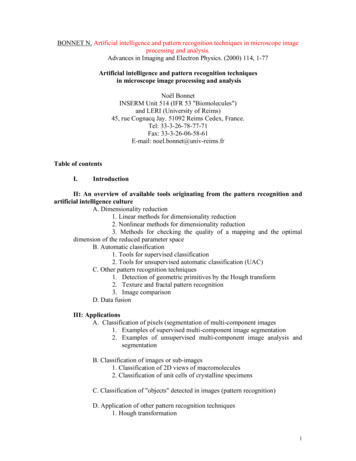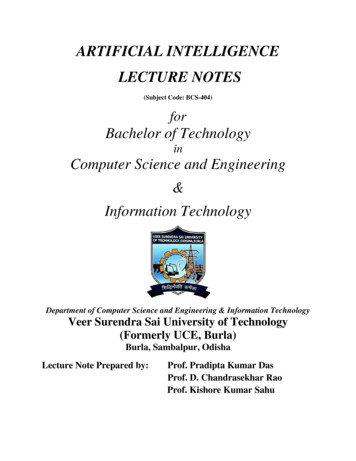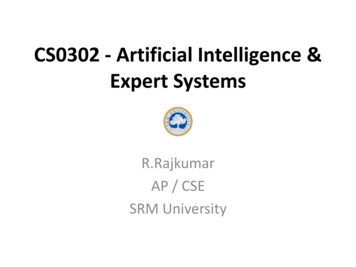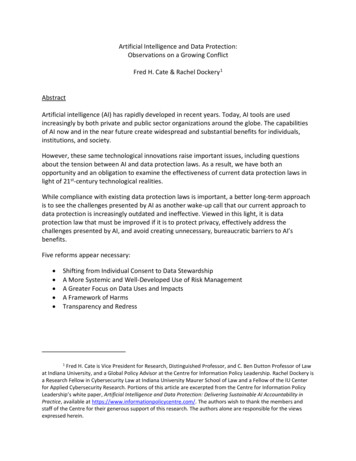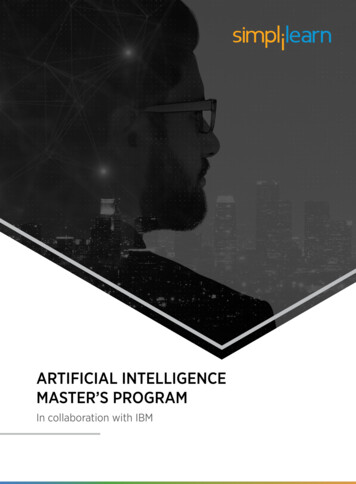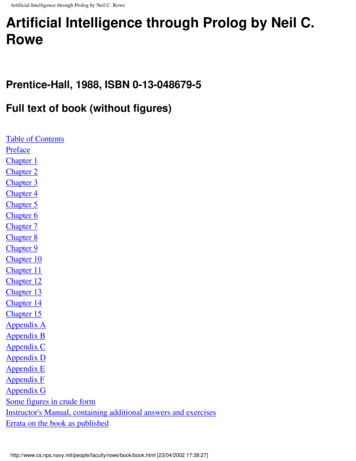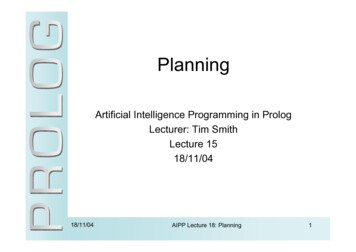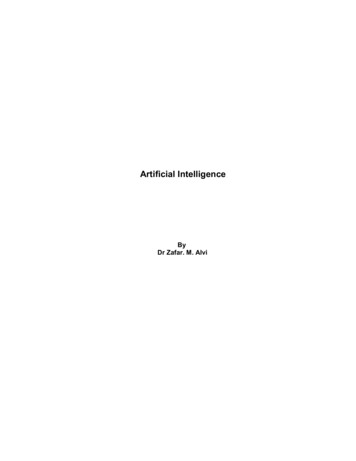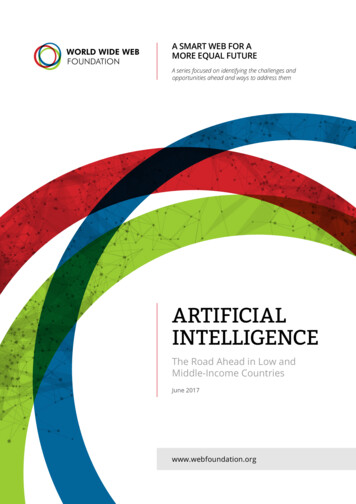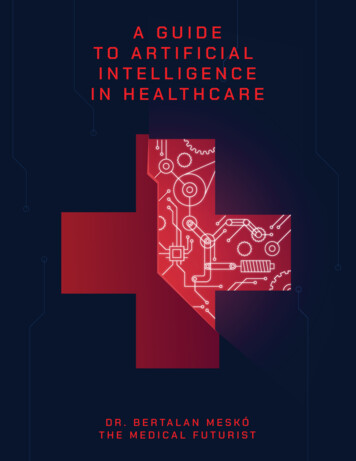
Transcription
A GUIDETO ARTIFICIALINTELLIGENCEI N H E A LT H C A R ED R . B E R TA L A N M E S K ÓT H E M E D I C A1 L F U T U R I S T
Authors:Dr. Bertalan Meskó & Nóra RadóTitle:A GUIDETO ARTIFICIAL INTELLIGENCEIN HEALTHCARECopyright:The Medical Futurist 20192
CONTENTSPart I. THE BASICS OF ARTIFICIAL INTELLIGENCEArtificial intelligence: a reference point for innovationFears and expectations about A.I.Let the quest for balanced views on A.I. beginWhat is Artificial Intelligence?Narrow, general, or super?What do you need for developing A.I.?Data Analytics, Machine Learning & Deep Learning – Methods of Teaching AlgorithmsData in healthcareA brief history and the current state of electronic medical recordsWhy do we need help from A.I. when it comes to data?Health data managementTreatment pathway designTransforming diagnosticsHealth assistance and administrationPatient managementPrecision medicineSupporting pharma: drug creation and clinical trialsFDA-approved Algorithms in HealthcarePart II. APPLYING ARTIFICIAL INTELLIGENCE IN HEALTHCAREHealth data managementTreatment pathway designTransforming diagnosticsHealth assistance and administrationPatient managementPrecision medicineSupporting pharma: drug creation and clinical trialsFDA-approved Algorithms in HealthcarePart III. CHALLENGES OF ARTIFICIAL INTELLIGENCEMisconceptions and overhypingTechnological limitations of A.I.Limitations of available medical dataThe indispensable work of data annotatorsJudgemental datasets and A.I. bias in healthcareThe need to regulate A.I.The ethics of A.I.Could you sue diagnostic algorithms or medical robots in the future?Should algorithms mimic empathy?Could A.I. Solve The Human Resources Crisis In Healthcare?Part IV. MEDICAL PROFESSIONALS, A.I. AND THE ART OF MEDICINE3
Part I.THE BASICSOF ARTIFICIAL INTELLIGENCEArtificial intelligence: a reference point for innovationIn the last couple of years, artificial intelligence has evolved from a futuristic promise into anunavoidable reference point for innovation. Not only does it appear daily in news headlines,but the number of A.I.-related studies, research projects, university courses, and companieshas grown exponentially, not to speak about the rapid improvement in the precision of thetechnology. The initiative called A.I. Index in its 2018 Annual Report found that from January2015 to January 2018, active A.I. startups increased by 113 percent, while all active startups onlyshowed a moderate increase of 28 percent. Research into A.I. is similarly accelerating. Nothingpresents that better as the number of studies published in the medical field. While in 2005,there were only 203 research papers on Pubmed.com, one of the most prestigious databasesfor life sciences, the number rose to 7668 in 2018 and it’s likely to hit a new record in 2019.4
It was only a matter of time until the strategic importance of A.I. was recognized by fields otherthan tech industry, thus in recent years, we could follow closely how it has spilled over from theeconomy to politics as well. A.I. Index noted how the frequency of the expression’s usage hasskyrocketed in the last couple of months. In the U.S. Congress, the terms ‘artificial intelligence’and ‘machine learning’ were used in 2018 more times than in the previous years in total. Thisis also reflected in the visible A.I. race between countries, especially China and the West, aswell as political steps such as plans for the International Panel on Artificial Intelligence toassess the impact of the technology, including deeply divisive ethical considerations.Thus, the expressions of deep learning, machine learning, smart algorithms, augmentedintelligence, cognitive computing, and of course, artificial intelligence have all become part ofour lives just as kale emerged as a necessary ingredient to a healthy diet or reusable mugs asmeans to reduce disposable coffee cups and the amount of trash. They definitely started toreshape the world around us.“A.I. technologies will be the most disruptive class of technologies over the next 10 yearsdue to radical computational power, near-endless amounts of data and unprecedentedadvances in deep neural networks,” said Mike J. Walker, research director at Gartner, a leadingresearch and advisory company providing information technology-related insight andmarket trend analysis already back in 2017. Since then, the abilities of self-driving cars, Siri,Cortana,chatbots helping people appeal their parking tickets, deep neural networks detectingsexual orientation from facial images, and recently the news about how deepfake videos –the synthesis of real footage and image sequences generated by artificial intelligence – andaudio recordings already as the source of crimes have been all over the World Wide Web.However, while A.I. definitely has the potential to fundamentally transform entire industriesfrom transportation to healthcare, there has been too much hype around the capabilities ofwhat A.I. can achieve today; and the term itself got diluted to the point where everythingfrom big data analytics to pre-programmed robotic refrigerators could come underthe term: artificial intelligence. Journalists overexcited about technology and click-baitnews articles did not help either in offering clarification. The story how Facebook shutdown an A.I. experiment because chatbots developed their own language after it wasmisrepresented by many news sites from India to Hong Kong, is a brilliant example howaggravating fears about A.I. becoming conscious and aiming for destroying the humanrace spread around. And that’s just one example out of a swarm of similar articles.5
ARTIFICIALINTELLIGENCEI ALEIFICART LIGENCLETINARTIFICIALINTELLIGENCNG NEWSBINGREAKSBNEWREAKNEINGNG NEWSBREAKING NEWSBREAKING NEWSBREAREAKINGNEWSBREAKINGENEWSBREAFears and expectations about A.I.A couple of years ago, when artificial intelligence appeared in the public narrative, it wasoften treated by two extremes: either as the source of ultimate evil aiming for the destructionof mankind or the means to solve every trouble on Earth. ‘A.I. will cut out the possibility ofmaking errors from a lot of industries’. ‘Self-driving cars will liberate plenty of time for doingother activities than driving’. ‘Intelligent robots will do monotonous work humans dislikesuch as administrative tasks, going underwater, and hacking in an underground mine’. Thesebenefits sound amazing, but we have to acknowledge, A.I. in its current form is far from this level.In addition, sentiments about A.I. sometimes swing in favor of the negative extreme nourishedby public figures as well as dystopian sci-fi stories. Stephen Hawking said more than oncethat the development of full artificial intelligence could spell the end of the human race.Elon Musk told Bloomberg’s Ashlee Vance, the author of the biography Elon Musk, that hewas afraid that his friend Larry Page, a co-founder of Google and now the C.E.O. of its parentcompany, Alphabet, could have perfectly good intentions but still “produce something evil byaccident”—including, possibly, “a fleet of artificial intelligence-enhanced robots capable ofdestroying mankind.” In September 2017, the SpaceX and Tesla CEO even said that competitionfor A.I. superiority among countries such as China or Russia could lead to World War III. Heexplained that he was not just concerned about the prospect of a world leader starting thewar, but also of an overcautious A.I. deciding “that a [pre-emptive] strike is [the] most probablepath to victory”. The possibility of developing autonomous, robotic, lethal weapons does notscare only Musk, however. In August, more than 100 robotics and A.I. pioneers, including Tesla CEOand Alphabet’s Mustafa Suleyman, were calling for a UN-led ban of lethal autonomous weapons.Moreover, artistic interpretation tends to favor human-machine interaction as damaging: thecreation is pitted against its creators, aspiring ultimately to supplant them. Science fictionis full of robots-usurping-humans stories, sometimes entwined with a second strand of6
anxiety: seduction. Machines are either out to eliminate us (Skynet from Terminator 2, Hal in2001: A Space Odyssey), or to hoodwink us into a state of surrender (the simulated world ofThe Matrix, the pampered couch potatoes of WALL-E). On occasion, they do both.However, the trend of representing the relationship between humans and intelligent machinesgot, perhaps, more sophisticated, and a pinch more positive lately: Interstellar presented howto work together with an A.I. system efficiently, Her showed what happens when humans fallin love with artificial intelligence, and Mother demonstrated what it might look like when anintelligent machine raises a human child.Not only works of art, but articles about A.I. could also be characterized with a splash of positivitylately. The above-cited A.I. Index report shows that since early 2016, articles about the technologyhave become more positive, when articles went from 12 percent positive in January 2016 to 30percent positive in July 2016, and the percentage of positive articles has hovered near 30 percentsince then. The reasons might be on the one hand the recognition of the huge potential in A.I. tobring positive change in many industries, and on the other hand, the move from the abstract ideaof A.I. deeper down the rabbit hole might have resulted in a more positive stance towards thetechnology - as with machine learning, deep learning, and co. people see how far we are fromconscious A.I., but also how they can solve specific tasks much better than humans.Let the quest forbalanced views on A.I. beginThus, we believe that Elon Musk’s fears aboutthe development of A.I. being „summoning the devil”are way too exaggerated. However, while thetechnology has much potential for transformingsociety, the latest positive attitudes might also be inflated.As the Gartner Hype Cycle, the most reliable indicator for hype around new technologies,has shown, artificial intelligence, machine learning, and deep learning have stationed forthe last 3-4 years at the “peak of inflated expectations”. So, next up should be a necessaryrecalibration of the realm - one that will separate the true meaning of A.I. from the hypesand fears, as well as the winning A.I.-driven companies from all the remaining noise.7
EXPECTATIONSWe need balanced analyses about the nature of A.I., as well as its risks, its capability andits potential consequences so that we could prepare for the sweeping changes it brings forevery industry, especially healthcare. Principally because public attitudes towards A.I. varygreatly depending on its application – and healthcare does not feature very high on the listof accepted uses. According to a YouGov survey for the British Science Association of morethan 2,000 people, fully 70 percent of respondents are happy for intelligent machines to carryout jobs such as crop monitoring – but this falls to 49 percent once you start asking abouthousehold tasks, and to a miserly 23 percent when talking about medical operations in hospitals.And why exactly should we set the terms of the human-machine interaction as a zero-sumgame? What if we thought about A.I. rather as an innovative cooperative form between twoplayers? In 1997, IBM’s supercomputer Deep Blue could beat Garry Kasparov, the reigningchess grandmaster. He said he could have performed better if he had had access to the samedatabases as Deep Blue. So later, freestyle matches were organized in which supercomputerscould play against human chess players assisted by A.I. (they were called human/A.I. centaurs).As a result, in 2014 in a Freestyle Battle, the A.I. chess players won 42 games, but centaurswon 53 games. The best potential pair is a human with technology. This is the only balancethat can lead to a positive future with more and more disruptive innovations including everimproving cognitive computing but also ever-improving human intelligence and wisdom.However, for arriving at a successful cooperation between these two players, we need tounderstand what we are dealing with. So, let the quest begin!8
What is Artificial Intelligence?Artificial intelligence or A.I., is a broad term „conjuring up” everything from being the latesttool in salesforce through the conscious mind behind Scarlett Johansson’s voice in the movie„Her” until the program that trounces the best human players at Jeopardy! When you dissectit, you will find artificial narrow, general and super-intelligence, deep and machine learning,supercomputers and GPUs (graphic processing units - specialized electronic circuits designedto rapidly manipulate and alter memory to accelerate the creation of images) as well as theTuring test behind it.The term was mentioned for the first time in 1956 by John McCarthy during the DartmouthSummer Research Project on Artificial Intelligence (DSRPAI) where several scientists decidedto meet to look at whether machines could reach intelligence. According to the definitionused at Stanford University, it is the science and engineering of making intelligent machines,especially intelligent computer programs. It is related to the similar task of using computersto understand human intelligence, but A.I. does not have to confine itself to methods thatare biologically observable. In this context, intelligence means the computational part of theability to achieve goals in the world. Varying kinds and degrees of intelligence occur in people,many animals and some machines.A narrower definition signalling the most common understanding of A.I. was coined bythe European Parliament’s Citizens’ Rights and Constitutional Affairs Policy Department.According to their term, it is the capability of a computer program to perform tasks orreasoning processes that we usually associate to intelligence in a human being. It often has9
to do with the ability to make a good decision even when there is uncertainty or vagueness, ortoo much information to handle. When we define A.I. as the latter, where intelligence meansbasically human-level intelligence, then we don’t have artificial intelligence today yet.There is also the question of how to know if we have reached the stage of human-intelligencelevel A.I. That’s where the Turing test comes into play. In 1950, British mathematician AlanTuring wrote a paper, titled “Computing Machinery and Intelligence“, in which he examinedthe question, “Can machines think?” Turing’s answer was yes, and he predicted that, by asearly as the beginning of the 21st century, machines would be able to pass an intelligence testthat he proposed, now famously known as the Turing test. A human interrogator is taskedwith determining which of two chat-room participants is a computer, and which is a realhuman. The interrogator can say or ask anything, but all interaction is solely through typedtext. If the interrogator cannot distinguish computer from human with better than 70 percentaccuracy after 5 minutes of interacting with each participant, then the computer has passedthe test. To date, there is no computer which was able to pass. There is no consensus whenwe might reach that stage. Some people suggest that it’ll happen somewhere around 2029.Others think that this might happen somewhere closer to 2040. However, most people agreethat it’ll happen in our lifetime.Narrow, general, or super?The literature and experts break down A.I. into various types and stages according to its currentcapacity as well as its potential performance in the near or distant future. If we assume thatthe broader goal is to achieve a level of intelligence in machines similar to that of humans, firstwe have to see the howling difference between the way computers and humans work. Whenpeople see an object like a chair, they are able to recognize its distinctive features and apply itto exactly the same and many other different chairs as well. As Dave Gershgorn described it inQuartz here, machines are very literal - a computer doesn’t have a flexible concept of “similar.”A goal of artificial intelligence is to make machines less literal, thus recognizing a swarm ofchairs, the concept of a chair or the same chair photographed in different light.This is called “generalizing” or forming an idea that’s based on similarities in data, rather thanjust the images or text the A.I. has seen. “The goal is to reduce a complex human behaviour to aform that can be treated computationally,” says Alex Rudnicky, a computer science professor10
at Carnegie Mellon University. “This in turn allows us to build systems that can undertakecomplex activities that are useful to people.”To avoid confusion with the more general expression, experts prefer to use the term ArtificialGeneral Intelligence (AGI) to refer to that level of intelligence when a machine is capable ofabstracting concepts from limited experience and transferring knowledge between domains.Thus, being able to pair the concept of a chair not only with pictures but also text, etc. AGI isalso referred to as “Strong A.I.” to differentiate against “Weak A.I.” or “Narrow A.I.”, which aresystems designed for a specific task whose capabilities are not easily transferable to others.On the science-fiction sounding end of the scale is “Artificial Superintelligence”, which refersto a form of intelligence which is more powerful than the human brain. It is very tricky asscientists and experts have not even mapped what the human brain is capable of, thus weare very far from it in reality.However, there is the field of Artificial Narrow Intelligence (ANI), which is developing at anincredible speed. These narrowly intelligent programs defeat humans in specific tasks, suchas IBM’s supercomputer Deep Blue winning at chess but unlike human world champions,these algorithms are not capable of also driving cars or creating art. Solving those other tasksrequires other narrow programs to be built, and it is an immense challenge for computers toconnect the dots. Yet, there is incredible growth in computers’ ability to understand imagesand video, a field called computer vision, as well as text in the frames of natural languageprocessing. The former is used as a primary technology for self-driving cars, Google imagesearch, automatic photo-tagging on Facebook, and it is extensively utilized now in healthcare,for example in the field of medical imaging.TLET’S GO OUNFOR A RUTHEMEANINGOFLIFE11
What do you need for developing A.I.?The theoretical background and ideas about A.I. have been around for 50-60 years already, butthere were two decisive factors why A.I. research started to boom in the last decade. The firstelement is computational power, the second is the vast amount of data needed to be accumulated.In the mid-2000s graphics processor unit (GPU) company Nvidia concluded that their chipswere well-suited for running neural networks, and began making it easier to run A.I. on theirhardware. Researchers found that being able to work with faster and more complex neuralnetworks led to more improvement in accuracy. From that time on, there has been a fiercecompetition in the tech industry to build faster and stronger computers able to processand store more and more data. IBM, Hewlett-Packard, Cray or Dell are all developing highperformance computers, so-called supercomputers, which are able to process unimaginableamounts of information.Thus, we arrived at the other key element for building artificial intelligence: data. Algorithmsneed to be fed with enormous amounts of data to be able to arrive at ANI. Currently, the amountof available digital data is growing at a mind-blowing speed, doubling every two years. In 2013, itencompassed 4.4 zettabytes, however by 2020 the digital universe – the data we create and copyannually – will reach 44 zettabytes, or 44 trillion gigabytes (!). This vast amount of data not onlyenables, but alreadynecessitatesthe presence ofalgorithms being ableto make sense ofbig data.Data Analytics, Machine Learning & Deep Learning –Methods of Teaching AlgorithmsThe methods for making sense of huge data sets and reaching ANI require IT andprogramming background. Here, we do not intend to go into the technical details, weonly would like to familiarize interested readers with the broad concepts to be able todifferentiate among them and select the most appropriate ones for their goals. Althoughmore complex data analysing methods sound exciting and appealing, sometimes you canarrive at great results by using less advanced techniques. For example, in a small Hungarianhospital, the pre-treatment waiting time for oncology patients dropped drastically from54 to 21 days only by optimizing patient management processes with the help of simple‘tricks’ such as recording and following-up cases closely. The first step for data analytics isrecording data appropriately – and then carrying out the necessary follow-up actions.12
The second step is using various statistical methods, such as data mining for collecting,analyzing, describing, visualizing and drawing inferences from data, for example fromelectronic health records or the ‘OMICS’ universe. The focus is on discovering mathematicalrelationships and properties within datasets and quantifying uncertainty. Data mining usuallymeans when insights and patterns are extracted from large-scale databases.However, this is only the ante-room of artificial intelligence. The next step should be thecreation of symbolic systems where the most frequently used programs are so-called expertsystems. The method was introduced by researchers at Stanford University, and representedthe main line of artificial intelligence research from the mid-1950s until the late 1980s. Expertsystems are comprised of a knowledge base, an inference engine, which uses IF-THEN-ELSErules to make sense of the dataset and a user interface, where a user receives the requiredinformation. Such systems are best applied to automate calculations and logical processeswhere rules and outcomes are relatively clear.Here, the program is only able to carry out the set of specific rules which a computer engineerprogrammed it to do. Machine learning goes far beyond that. It is the field of computer sciencethat enables computers to learn without being explicitly programmed and builds on top ofcomputational statistics and data mining. As with conventional statistics, machine learningrequires sufficient training datasets (also known as sample size in traditional statistics) and theright algorithms to optimize its performance on the training dataset before testing. However, incontrast to the traditional methods, it is focused on building automated decision systems.Machine learning has different types: it could be supervised, unsupervised, semi-supervisedor reinforcement learning.The first one, supervised machine learning, is typically used for classification problems, e.g.pairing pictures with their labels. Thus, you have an input and output data – the image as wellas the label -; and the algorithm learns general rules how to categorize. It is the most populartype of machine learning in medicine, and in a few years, it will be widely used in medicalimaging in radiology, pathology, and other image-intensive fields. However, it certainly hasits limitations: it requires large data sets to become accurate enough, and the data has to beappropriately labelled. That’s why the work of data annotators is so crucial.13
Nevertheless, supervised machine learning can also be effectively deployed to predict healthevents based on various input data, which can be classified in a linear way. For example, fromstatistics on measles vaccination rates and disease outbreaks from the Centers for DiseaseControl and Prevention, as well as non-traditional health data, including social media andsyndromic surveillance data generated by software that mines a huge range of medicalrecords sources, an algorithm can provide a reliable map of future measles outbreak hotspots.In the case of unsupervised machine learning, the computer program is asked to discoverinherent structure and patterns that lie within the data. Unlike in the case of supervisedmachine learning, it has to make up its own groups, usually called ‘clusters’, and categoriesbased on certain similarities in huge data sets. It is usually used to predict unknown resultsand to determine how to discover hidden patterns. Unsupervised machine learning hassubtypes: clustering algorithms and association rule-learning algorithms. It is widely usedand has been implemented, for example, in self-driving vehicles and robots as well as beingused in speech- and pattern-recognition applications. In medicine, for example, tissuessamples can be clustered based on similar gene expression values using unsupervisedlearning techniques. As an example of association rule-learning algorithms, the testing ofnovel drug-drug interactions can be mentioned.Semi-supervised learning lies between supervised and unsupervised learning, where theinput-output pairs are incomplete – the labels are missing or the information is noisy. Itsuse is especially justified in healthcare, where a large body of data, especially looking atelectronic medical records, lack information necessary to apply supervised machine learning.Thus, researchers are looking at ways to address the problem of making use of unlabeledor un-scored data, together with only a few supervised data, to improve the performance ofanalysis model for healthcare decision making.The last category, reinforcement learning constitutes probably the most known type ofmachine learning: when the computer program learns from its mistakes and successes; andbuilds its experiences into its algorithm. The most famous example for it is AlphaGo, themachine developed by Google that decisively beat the World Go Champion Lee Sedol in March2016. Using a reward and penalty scheme, the model trained on millions of board positions inthe supervised learning stage first, then played itself in the reinforcement learning stage toultimately become good enough to triumph over the best human player.14
However, the problem with applying reinforcement learning to healthcare, especially foroptimizing treatment, is that unlike with AlphaGo, we cannot play out a large number ofscenarios where the agent makes interventions to learn the optimal policy – as the lives ofpatients are at stake. Luckily, we already have examples where this issue can be mitigated.In a study published by MIT researchers, the authors reported a successful formulation ofclinical trial dosing as a reinforcement learning problem, where the algorithm taught itselfthe appropriate dosing regimens to reduce mean tumor diameters in patients undergoingchemo- and radiation therapy clinical trials.Deep learning is a subfield of machine learning where computers learn with the help of layeredneural networks. What are neural networks? Quartz formulated the explanation for themas the followings: algorithms which are roughly built to model the way the brain processesinformation, through webs of connected mathematical equations. Data given to a neuralnetwork is broken into smaller pieces and analyzed for underlying patterns thousands tomillions of times depending on the complexity of the network. A deep neural network is whenthe output of one neural network is fed into the input of another one, chaining them togetheras layers. Typically, the layers of a deep neural network would analyze data on higher andhigher levels of abstraction, meaning they each throw out data learned to be unnecessaryuntil the simplest and most accurate representation of the data is left.Deep learning has different types used for reaching ANI in various areas. Convolutional neuralnetworks (CNN) are typical for recognizing images, video, and audio data, due to their abilitiesto work with dense data. Recurrent neural networks (RNN) are used for natural languageprocessing, while long short-term memory networks (LSTM) are variations of RNNs meantto retain structured information based on data. For instance, an RNN could recognize all thenouns and adjectives in a sentence and determine if they’re used correctly, but an LSTM couldremember the plot of a book.Deep learning requires plenty of expertise, thus only a few technology companies managedto apply it to already marketed products. Google, Microsoft, IBM, Amazon, Baidu, or Tencentare the biggest developers of deep learning algorithms. Just think about Google’s translationservice, Google Translate, and you will be aware of the fact that you have already used oneof the most popular products powered by deep learning. As an example of deep learning inmedicine, researchers proposed an approach to deduce treatment policies for septic patientsby using continuous state-space models and deep reinforcement learning. In another study,15
experts attempt to solve the difficult problem of estimating polyp size using colonoscopyimages or videos, which is crucial for making a diagnosis in colon cancer screening. Moreover,unsupervised deep learning may facilitate the exploration of novel factors in score systems orhighlights hidden risk factors to existing models. It can also be used to classify novel genotypesand phenotypes from pulmonary hypertension, cardiomyopathy, and many other factors.There is one more expression that is worth getting familiar with as it will be heard a lotmore in the future: the concept of an open A.I. ecosystem. It was named as one of the top 10emerging technologies in 2016 by the World Economic Forum. An open A.I. ecosystem refersto the idea that with an unprecedented amount of data available, combined with advancesin natural language processing and social awareness algorithms, applications of A.I. willbecome connected. Devices, algorithms and humans will constitute one “living ecosystem” inwhich data will flow without barriers.Data in healthcareAfter getting to know the most important terms, definitions and method
technology has much potential for transforming society, the latest positive attitudes might also be inflated. As the Gartner Hype Cycle, the most reliable indicator for hype around new technologies, has shown, artifici
